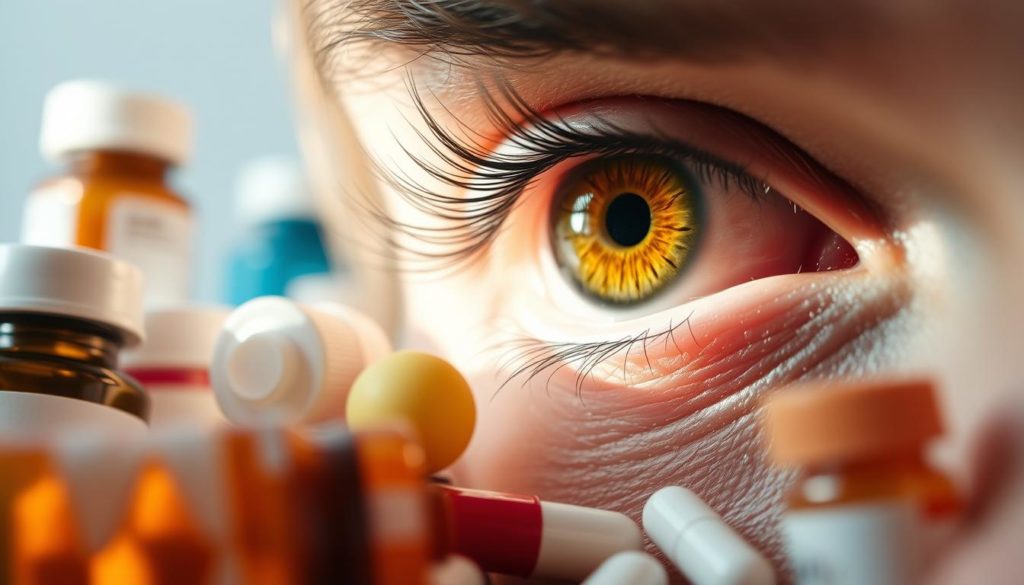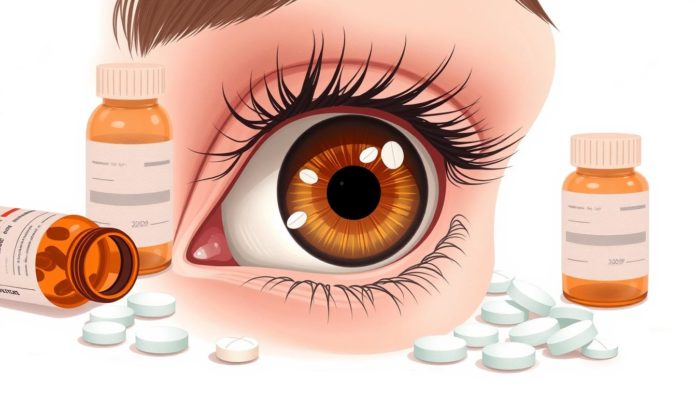Did you know that over 15 million Americans have dry eye syndrome? Many of them link their symptoms to everyday medications. It’s shocking but true. Many medications, like antidepressants and blood pressure drugs, can cause medication-induced dry eye.
The discomfort from dry eye syndrome can range from mild to severe. It can really affect how we live. To help those suffering, it’s key to understand what causes it. This includes knowing which medicines are often at fault. Learning how to control and prevent drug-induced dry eye is also vital.
Understanding Medication-Induced Dry Eye
Medication-induced dry eye happens when some common drugs affect your eyes. These drugs might stop your eye from making tears properly. Or they could mess up the tear film that keeps your eye moist. When using some medicines, people could get dry eyes. This is because of how the medicines affect your nerves, hormones, or fluids in your body.

It’s important to know the signs and get why certain meds cause dry eye. People with this problem often feel discomfort in their eyes. Symptoms include dryness, irritation, and feeling like there’s sand in their eyes. These issues usually come from how certain drugs impact the eyes.
How Do Medications Cause Dry Eye?
Some medications affect our eyes by changing how tears are made. They can also change the tear’s makeup. These changes can lead to eye problems, which are common due to many people taking medicines. Knowing how this happens can help us deal with and prevent dry eyes.

Reduction in Tear Production
Certain meds can make us produce fewer tears. This happens because they impact the nerves involved. Drugs for depression and Parkinson’s disease are examples. They can lower tear amounts, causing dry eyes. It’s important to find the right balance in medication to avoid this.
Changes in Tear Composition
Some medications can change what our tears are made of. For instance, hormone drugs can alter oils or proteins in tears. This can mess with tear film’s quality. While these drugs do their main job, we must watch out for these eye issues.
Common Classes of Medications That Cause Dry Eye
Many medications cause symptoms of dry eyes by affecting tears. Some drugs are known more for this issue.
Antidepressants and Mood Stabilizers
Drugs like tricyclics and SSRIs and dry eye can reduce tear production. This causes discomfort. They are used for depression and mood issues but can make dry eyes worse.
Antihistamines and Decongestants
Antihistamines and decongestants help with allergies but can reduce tear production. This is hard for people who are prone to dry eyes.
Hormonal Medications
Hormonal medicines, like birth control and menopause treatments, affect tears, too. They’re important but can worsen dry eye symptoms.
Blood Pressure Medications
Beta-blockers and eye dryness often come up together. They change tear makeup. Diuretics also decrease tear flow, troubling for those with high blood pressure.
Pain Relievers
Pain relievers, especially NSAIDs, are common. But they have a side effect: NSAIDs dry eye. It makes treating pain and eye health trickier.
Knowing which medications cause dry eye helps in finding treatment. It’s a key step in relieving discomfort.
Diagnosis of Drug-Induced Dry Eye
Identifying medication-induced dry eye begins with noticing dryness, irritation, and blurred vision. A full eye exam is key once these symptoms appear.
Eye care experts use various dry eye diagnostic tests to identify the issue. These include checking tear production and the stability of the tear film. The Schirmer test, which measures tear volume, is commonly used.
Doctors don’t just look at tear volume. They also study the make-up of tears through osmolarity tests. High osmolarity points to an unstable tear film, often resulting from medication use. Also, markers like MMP-9 in tears suggest inflammation from drug use, helping pinpoint identifying medication-induced dry eye.
Fluorescein staining is another key technique in dry eye diagnostic tests. It reveals damage to the eye’s surface, showing signs of dry eye disease.
A thorough diagnosis using these methods ensures we find and treat the real cause of dry eye, including when drugs are to blame.
Effective Treatment for Medication-Induced Dry Eye
Improving life with the right dry eye treatment is key. Options include adjusting meds, using tear substitutes, or advanced techniques. Each of these can help ease the discomfort.
Adjusting Medication Usage
Tweaking your meds can tackle dry eye. Talk to a doctor about lowering doses or trying new medications. This way, you can lessen dry eye issues but keep your main treatment effective.
Using Artificial Tears and Other Eye Drops
Artificial tears are crucial for dry eye relief. They work like your own tears and help right away. For tougher cases, doctors might suggest special prescription drops.
Punctal Plugs
Punctal plugs help keep your eyes moist. They block the tear ducts to stop tears from draining too fast. This method is great for those who can’t produce enough tears.
Thermal Pulsation and Other Procedures
Severe dry eye might need stronger treatments. Thermal pulsation or light therapy can kickstart tear glands. Plus, certain meds and eye insertables offer ongoing moisture.
| Treatment Method | Description | Benefits |
|---|---|---|
| Adjusting Medication Usage | Modify dosage or switch medications | Reduces root cause of dry eye |
| Artificial Tears | Over-the-counter tear solutions | Immediate moisture relief |
| Punctal Plugs | Inserts to reduce tear drainage | Retains natural moisture |
| Thermal Pulsation | Stimulates meibomian glands | Enhances tear production |
Managing Medication-Related Dry Eye Symptoms
Dealing with dry eye symptoms caused by medication requires combining expert advice and self-help measures. By adding effective managing medication-related dry eye tips to your daily life, you’ll see improved results and feel more comfortable.
Using artificial tears or ointments regularly is a key step. These help add moisture back to the eye’s surface, which eases discomfort. For the best effect, opt for versions without preservatives to reduce the chance of irritation.
An eyelid hygiene routine is also very helpful. Keeping your eyelids clean cuts down on inflammation and enhances eye surface care. Using a mild eye-specific cleanser is a good strategy.
Taking omega-3 fatty acid supplements is another effective method to improve your eye surface health. These can make your tears healthier and lessen dry eye symptoms. However, always talk to a doctor before starting any supplements.
Keep an eye on your medicine too. Certain meds, like retinoids and some cancer treatments, can negatively impact your eyes’ oil glands and tear production, making dry eye issues worse. For more info on how medications affect dry eye, check out studies here.
Mixing these eye care practices with professional advice is crucial to handle medication-related dry eye effectively. Balancing medical care and self-care tactics helps improve your eye health and comfort overall.
Do You Need to Change Your Medication?
If you constantly have dry eyes, think about if you need to change your eye health meds. Some drugs can change tear production and its quality, causing dry eyes. This includes meds like antidepressants, antihistamines, and beta-blockers.
Talk to a healthcare pro before changing your meds. They can figure out if your meds are drying out your eyes. Then, they can recommend other options.
Never halt any medication without professional guidance, as doing so could lead to other health complications.
There are ways to ease drug-induced dry eye relief. You might adjust your dose, switch your meds, or add eye treatments to your routine. For info on meds that can affect your eyes, visit this resource.
| Existing Medication | Potential Side Effects | Possible Alternatives |
|---|---|---|
| Antidepressants | Dry eye symptoms | SSRIs, SNRIs |
| Antihistamines | Reduced tear production | Non-sedating antihistamines |
| Beta-blockers | Changes in tear composition | Calcium channel blockers |
By carefully changing meds, you can manage both your health condition and eye health. It’s all about finding the right balance.
Preventing Dry Eye While Taking Medications
Good ocular health and medication handling can help prevent dry eye. It’s important to learn about the eye side effects of your medications. Talk with your healthcare provider about the risk of dry eye before you start any new drug. Ask them how you can lower this risk.
Getting regular eye exams is also vital. These exams let your eye doctor keep an eye on your eye’s health. They can act early if any issues arise. Always tell your doctor about all the medications you are taking. This way, they can give you the best advice.
Using eye drops recommended by your optometrist is a big help. The right use of artificial tears or special eye drops keeps your eyes moist. This ease the discomfort of dry eye. Make sure to follow the instructions on how often and how much to use.
To fight dry eye due to medication, stay informed and in touch with health care providers. Regular eye check-ups and the right use of eye drops are key. Always think of your eye health when you’re taking different medications. This way, you can stay healthy overall.
FAQ
What is medication-induced dry eye?
Medication-induced dry eye happens when certain medications affect your tears. They can make you produce fewer tears or change the tear’s quality. This leads to unpleasant symptoms of dry eyes.
Which classes of medications are commonly associated with dry eye?
Many medications could cause dry eyes. These include antidepressants, antihistamines, blood pressure medicines, and pain relievers.
How do medications lead to dry eye?
Some medicines can decrease tear production by affecting nerve signals. They might also change the composition of your tears. This disrupts the tear film on your eyes, causing dry eye symptoms.
What symptoms indicate medication-induced dry eye?
Dry eye symptoms include dryness, irritation, and redness. You might feel like there’s something gritty in your eyes. In severe cases, it can even blur your vision.
How is medication-induced dry eye diagnosed?
Doctors use eye exams and tests to diagnose this condition. They check your tear volume and the health of your eye’s surface. Analyzing tear samples can also show if medication is the cause.
What are the treatment options for medication-induced dry eye?
Treatment might involve changing the medication or its dosage. Using artificial tears or getting certain eye procedures can also help. It often takes a mix of methods to manage dry eye effectively.
Can changes in medication help relieve dry eye symptoms?
Yes, altering your medication or dosage may improve symptoms. But, always talk to a healthcare professional before making any changes.
Are there preventative measures to avoid dry eye while on medication?
To prevent dry eyes, know the side effects of your medicines. Get regular eye check-ups and use eye lubricants if necessary. Discussing new medications with a doctor beforehand can also prevent dry eye issues.


